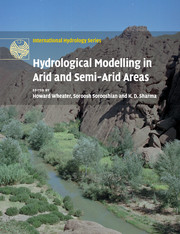Book contents
- Frontmatter
- Contents
- List of contributors
- Preface
- Acknowledgements
- 1 Modelling hydrological processes in arid and semi-arid areas: an introduction
- 2 Global precipitation estimation from satellite imagery using artificial neural networks
- 3 Modelling semi-arid and arid hydrology and water resources: The southern Africa experience
- 4 Use of the IHACRES rainfall-runoff model in arid and semi-arid regions
- 5 KINEROS2 and the AGWA modelling Framework
- 6 Ephemeral flow and sediment delivery modelling in the Indian arid zone
- 7 The modular modelling system (MMS): a toolbox for water and environmental resources management
- 8 Calibration, uncertainty, and regional analysis of conceptual rainfall-runoff models
- 9 Real-time flow forecasting
- 10 Real-time flood forecasting: Indian experience
- 11 Groundwater modelling in hard-rock terrain in semi-arid areas: experience from India
- Appendix Access to software and data products
- Index
- Plate section
3 - Modelling semi-arid and arid hydrology and water resources: The southern Africa experience
Published online by Cambridge University Press: 15 December 2009
- Frontmatter
- Contents
- List of contributors
- Preface
- Acknowledgements
- 1 Modelling hydrological processes in arid and semi-arid areas: an introduction
- 2 Global precipitation estimation from satellite imagery using artificial neural networks
- 3 Modelling semi-arid and arid hydrology and water resources: The southern Africa experience
- 4 Use of the IHACRES rainfall-runoff model in arid and semi-arid regions
- 5 KINEROS2 and the AGWA modelling Framework
- 6 Ephemeral flow and sediment delivery modelling in the Indian arid zone
- 7 The modular modelling system (MMS): a toolbox for water and environmental resources management
- 8 Calibration, uncertainty, and regional analysis of conceptual rainfall-runoff models
- 9 Real-time flow forecasting
- 10 Real-time flood forecasting: Indian experience
- 11 Groundwater modelling in hard-rock terrain in semi-arid areas: experience from India
- Appendix Access to software and data products
- Index
- Plate section
Summary
INTRODUCTION
Southern African hydrology is characterized by a high degree of variability with climate zones varying from tropical to extremely arid. Within individual climate zones, and particularly the semi-arid regions, hydrological (rainfall and streamflow) variability is as high as anywhere in the world (McMahon, 1979). While extremes of floods and droughts, and their social or economic consequences, tend to receive a great deal of publicity, it is often the less dramatic components of hydrological variability that present some of the greatest challenges to sustainable water-resource management. There are many basins within the region that have their headwaters in relatively wet and well-watered regions but then pass through much drier regions. The need to understand streamflow loss, as well as streamflow-generation processes increases the complexity of any modelling study. The fact that many of these rivers also cross national boundaries (Orange, Limpopo, Okavango, etc.) adds to the complexity of managing water resources at the regional scale.
The political and socio-economic history of the region has not been conducive to the collection and maintenance of hydrological records. Even today, despite the recognition of the importance of well-managed water resources to the health and socio-economic well-being of the region, the acquisition of the necessary information does not appear high on the agendas of many of the region's government institutions. Similar constraints have limited the development of local capacity within both the hydrological sciences and water-resource management fields.
- Type
- Chapter
- Information
- Hydrological Modelling in Arid and Semi-Arid Areas , pp. 29 - 40Publisher: Cambridge University PressPrint publication year: 2007
- 6
- Cited by

